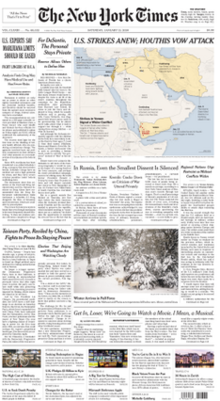Rumored Buzz on News Articles
Rumored Buzz on News Articles
Blog Article
Excitement About News Articles
Table of ContentsExamine This Report about News ArticlesNews Articles for Beginners5 Easy Facts About News Articles ShownThe Greatest Guide To News ArticlesUnknown Facts About News Articles
Great expertise of various subjects gives trainees a competitive edge over their peers. Despite the fact that electronic and social media are conveniently accessible, we must not fail to remember exactly how vital it is to read the newspapers. Moms and dads must try and instill the practice of reading a newspaper as a day-to-day regimen to continue the heritage of the adored print medium.Information tales also include at least one of the adhering to crucial attributes loved one to the intended audience: closeness, importance, timeliness, human passion, strangeness, or repercussion.
Within these limits, news tales additionally aim to be detailed. Amongst the larger and a lot more highly regarded newspapers, fairness and balance is a major factor in offering information.
Newspapers with an international audience, for instance, often tend to make use of a much more formal design of writing. The specific choices made by an information outlet's editor or content board are usually accumulated in a design overview; usual design guides include the and the US Information Design Book. The major goals of information writing can be summed up by the ABCs of journalism: accuracy, brevity, and clearness.
The 5-Minute Rule for News Articles
As a rule, reporters will certainly not use a lengthy word when a short one will certainly do. They make use of subject-verb-object building and vivid, active prose (see Grammar). They use stories, instances and allegories, and they seldom rely on generalizations or abstract ideas. News writers attempt to avoid utilizing the very same word extra than once in a paragraph (occasionally called an "resemble" or "word mirror").
Headings occasionally omit the subject (e.g., "Jumps From Watercraft, Catches in Wheel") or verb (e.g., "Pet cat lady fortunate"). A subhead (additionally subhed, sub-headline, subheading, caption, deck or dek) can be either a secondary title under the main heading, or the heading of a subsection of the short article. It is a heading that precedes the main message, or a team of paragraphs of the primary message.

Additional signboards of any of these kinds may show up later in the short article (especially on succeeding web pages) to attract more reading. Such billboards are likewise utilized as pointers to the article in other areas of the magazine or website, or as promotions for the item in various other magazine or sites. Common structure with title, lead paragraph (recap in vibrant), other paragraphs (details) and get in touch with info.

Example of a this page hard-lead paragraph NASA is recommending one more room task. The firm's spending plan demand, introduced today, consisted of a plan to send one more objective to the Moon. This moment the firm intends to develop a long-term center as a jumping-off factor for various other area experiences. The budget requests roughly $10 billion for the job.
An "off-lead" is the second most vital front page information of the day. To "hide the lead" is to start the short article with background information or details of additional importance to the viewers, requiring them to check out more deeply into an article than they must have to in order to find the necessary points.
News Articles Things To Know Before You Buy
Usual usage is that or two sentences each form their own paragraph. Reporters typically explain the company or framework of an information story as an inverted pyramid. The vital and most interesting elements of a tale are put at the beginning, with sustaining info adhering to in order of decreasing importance.
It enables people to check out a subject to just the depth that their curiosity takes them, and without the charge of details or subtleties that they could take into consideration pointless, yet still making that information readily available to a lot more interested viewers. The upside down pyramid framework likewise enables write-ups to be cut to any approximate length during design, to suit the space readily available.
Some authors begin their her response tales with the "1-2-3 lead", yet there are numerous kinds of lead readily available. This format invariably begins with a "5 Ws" opening up paragraph (as explained above), adhered to by an indirect quote that serves to support a major aspect of the very first paragraph, and after that a straight quote to sustain the indirect quote. [] A twist can describe several things: The last story in the news program; a "satisfied" tale to end the program.
Longer write-ups, such as magazine cover articles and the pieces that lead the within sections of a paper, are referred to as. Function tales vary from straight information in several ways. Foremost is the lack of a straight-news lead, the majority of the moment. Rather of supplying the significance of a story in advance, attribute authors might attempt to entice visitors in.
Facts About News Articles Uncovered
A feature's very first paragraphs commonly connect an interesting minute or occasion, as in an "anecdotal lead". From the particulars of an individual or episode, its view swiftly expands to abstract principles regarding the tale's subject.

The Editor's Tool kit: A Recommendation Overview for Beginners and Professionals (2001) Allan M. Siegal and William G. Connolly. The New York Times Guidebook of Style and Use: The Official Style Overview Made Use Of by the Writers and Editors Discover More of the World's A lot of Authoritative Paper (2002) M. L. Stein, Susan Paterno, and R.
Report this page